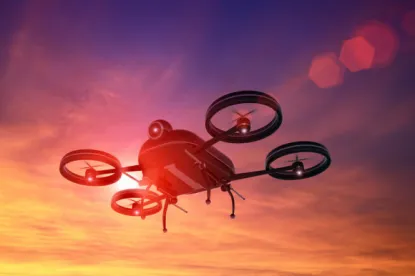Last Friday, in Taylor v. Huerta,[1], the DC Circuit Court of Appeals vacated a rule requiring individuals who fly small (weighing between 0.55 and 55 pounds on takeoff) drones and other model aircraft for hobby or recreational purposes to register with the Federal Aviation Administration (FAA).
Taylor serves as a reminder that, despite rapid advancements in drone technology, our regulators—and our society—are still in the very early stages of figuring out how to integrate these versatile devices into our airspace.
Hobbyist Registration
In December 2015, in response to concerns that "hundreds of thousands" of consumer drones would be unleashed on unsuspecting airspace during the holiday season,[2] the FAA issued the Registration and Marking Requirements for Small Unmanned Aircraft rule (Registration Rule).[3] The Registration Rule targeted "model aircraft," which are unmanned aircraft capable of sustained flight in the atmosphere, flown within visual line of sight of the operator, that are flown for hobby or recreational purposes. [4]
As we noted last year, the Registration Rule required individuals aged 13 or older who operate any model aircraft weighing more than .55 pounds (250 grams)[5] to register with the FAA. Registration was effective for three years, cost $5 and required an operator to provide the FAA with their name, home address, email and credit card information. Failure to comply could result in civil penalties, fines of up to $250,000 and even prison time.[6]
Taylor v. Huerta
The Registration Rule faced immediate opposition from hobbyists and hobby organizations.[7] John Taylor, an attorney and model aircraft enthusiast, filed a pro se challenge to the Registration Rule on December 24, 2015.[8]
Taylor alleged that the FAA had violated Section 336 of the FAA Modernization Act of 2012 (Act), known as the "Special Rule for Model Aircraft."[9] Section 336(a) of the Act prohibits the FAA from promulgating "any rule or regulation regarding a model aircraft."[10]
The Administrative Procedure Act defines a "rule" as "a statement of general or particular applicability and future effect designed to implement, interpret or prescribe law or policy."
The Registration Rule expressly referenced model aircraft in its text (even using the exact same definition for "model aircraft" as the Act) and prescribed new obligations and requirements for such aircraft.[11]
As a result, the DC Circuit held that the Registration Rule was a "rule regarding model aircraft." Because such rules are prohibited by the Act, the Registration Rule was unlawful. In Judge Kavanaugh's words, "statutory interpretation does not get much simpler."[12]
Commercial Use is Unaffected
Taylor is narrow in scope. It only applies to model aircraft, which are small unmanned aircraft flown for recreational or hobby purposes. All other uses, including commercial uses, of unmanned aircraft remain bound by the registration and certification requirements of the Federal Aviation Regulations Part 107.
Conclusion
Taylor reinforces the fact that Congress has tied the FAA's hands with regard to model aircraft regulation. As a result, any further attempts to regulate consumer use of drones for recreational purposes would need Congressional authorization or another means of bypassing Section 336 of the Act.
It will be interesting to see if the FAA decides to lobby Congress to grant it authority over model aircraft in the coming weeks and months. There is an opportunity for Congress to grant it such authority because the FAA is going through its reauthorization process this year.
[1] Taylor v. Huerta, No. 15-1495 (D.C. Cir. May 19, 2017).
[2] Press Release – FAA Announces Small UAS Registration Rule, Federal Aviation Administration (Dec. 14, 2015), https://www.faa.gov/news/press_releases/news_story.cfm?newsId=19856&cid=TW378.
[3] Registration and Marking Requirements for Small Unmanned Aircraft, 80 Fed. Reg. 78593 (Dec. 16, 2015), available here.
[4] FAA Modernization and Reform Act of 2012, Pub. L. No. 112-95, 126 Stat. 11 (codified at 49 U.S.C. § 40101) § 336(c) (2012).
[5] The FAA helpfully clarified that 250 grams was approximately the weight of "two sticks of butter." Your guide to obeying the new drone laws, CNN.com (December 25, 2015), http://money.cnn.com/2015/12/24/technology/drone-faa-laws-registration/.
[6] Registration and Marking Requirements for Small Unmanned Aircraft, 80 Fed. Reg. 78593, 78630 (Dec. 16, 2015).
[7] Academy of Model Aeronautics, Update – UAS Registration Frequently Asked Questions, AMA Government Relations Blog (Feb. 4, 2016) here.
[8] Taylor also challenged the FAA's Advisory Circular 91-57A, which prohibited the operation of model aircraft in certain areas such as the restricted zone around Washington, D.C., on similar grounds. However, 49 U.S.C. § 46110(a) requires that any challenge to an FAA order be filed within 60 days of the issuance. Taylor's challenge to the Advisory Circular was untimely, and was therefore denied. Taylor, at *9-10.
[9] FAA Modernization and Reform Act of 2012, Pub. L. No. 112-95, 126 Stat. 11 (codified at 49 U.S.C. § 40101) § 336 (2012).
[10] Id. at § 336(a).
[11] Registration and Marking Requirements for Small Unmanned Aircraft, 80 Fed. Reg. 78593, 78594 (Dec. 16, 2015), available here
[12] Taylor v. Huerta, No. 15-495 at *7 (D.C. Cir. May 19, 2017).




 />i
/>i

